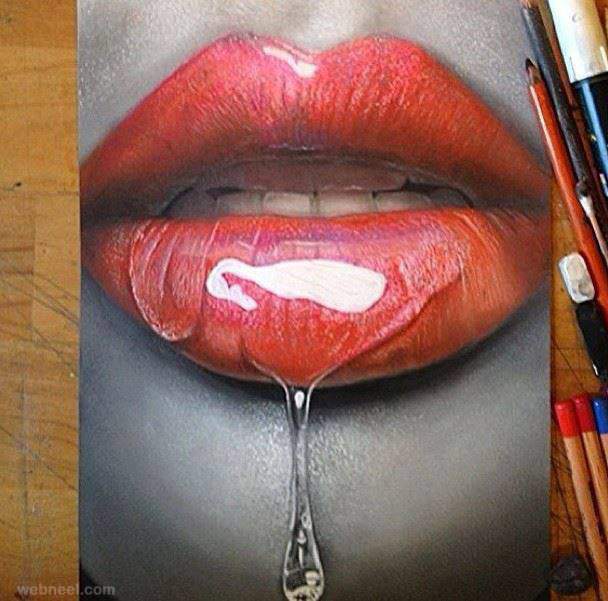Drawing - Top 10 Mistakes Beginners Make
how to improve . Without a teacher to help, we tend to keep making the same mistakes for longer than a student in a classroom. The key to overcoming this obstacle is to learn to look at your work with a fresh, critical eye. We should feel rightly proud of the progress we make each time we create a new drawing - don't let small flaws spoil your enjoyment! We need mistakes because they help us to learn. Here is a list of the most common mistakes that beginners make. Some of them are small, some are big, and all can be fixed.
For best results in assessing your work, choose a few pieces that you completed some time ago - you can more easily be critical of a work that you haven't only just finished. Look for each of the mistakes listed, and choose one or two things to concentrate on next time you draw. Don't try to fix everything at once, and remember that it's more important to enjoy the drawing process!
1. Using A Hard Grade of Pencil
If you have no very dark shadows and the whole picture is rather pale, check your pencil. Are you using a Number2 (HB) pencil? These are too hard to draw with (though they are handy for light shading). Get a B, 2B and 4B for darker values. Read more about pencil grades.
2. Using Flash in Portrait Photography
This is the major cause of beginner drawing problems. Using flash photography flattens the features, giving you nothing to work with. When the person is facing you, it is very hard to see the modeling of the face, as the perspective vanishes behind their head, and add a cheesy snapshot grin and you make life very hard! Have the person turning slightly to one side so you can model their face, with natural lighting to give good skintones, and a natural expression to show their real personality.
3. Problems With Head Proportion
Because of the way we focus on a person's features, we usually draw them too big and squash the rest of the head. Does your drawing look like the forehead is too small, or the back of the head is flat? Learn about the correct head proportions
4. Facial Features Not Aligned
Because we are used to looking at a person straight-on, we naturally try to make their features look level when we draw them. If their head is on an angle, this results in strange distortions in the picture. Sketch guidelines first to ensure that the features are on the same angle as the rest of the face. Learn more about placement of the eyes.
5. Drawing Pets From Human Eye Level
When you take a photograph standing up, you are looking down at your pet. They have to look up, and you end up with their head seeming much bigger than their body, and a rather odd expression on their face. Have someone distract them so they aren't staring down the lens, and squat down so the camera is at their head level, and you'll get a much better reference photo. Read more about pet photography for drawing.
6. Being Afraid to Draw Black
Often when shading, the shadows don't go past dark gray. If your value range is restricted to in some cases half what it ought to be, you are limiting the modelling and depth in your drawing. Put a piece of black paper at the corner of your drawing, and don't be afraid to go dark. Really dark. Try practicing graded and continuous shading.
7. Outline in Value Drawings
When value drawing, you are creating an illusion with areas of tonal value. When you use a hard drawn line to define an edge, you disrupt this illusion. Let edges be defined by two different areas of tonal value meeting. Read more about Value Drawing.
8. Using the Wrong Paper
If your drawing is pale, it might be the paper. Some cheap papers have a sheen on the surface that is too smooth to grab the particles off the pencil. A thick notepad has too much 'give' under the pencil to allow you to apply enough pressure. Try a basic photocopy/office paper, or check the art store for cheap sketch paper. Place a piece of card under a couple of sheets to give a firmer surface. If you are trying to do even shading, some sketch papers can be too coarse, giving an uneven texture. Try a hot-pressed Bristol board or similar smooth drawing paper. Find out more about which paper to use for graphite pencil.
9. Scribbled Foliage
Don't use circular scribbles to draw foliage. Use more convex shaped scumbling - like crescent shapes and scribbly calligraphic marks - to draw the shadows in and around clusters of foliage, and your trees will look much more realistic.
10. Using Pencil Lines For Hair and Grass
If you try to draw every hair or blade of grass as a single pencil line, you'll end up with an unnatural-looking mess of tangled wire. Instead, try to make feathery pencil-strokes to draw the shadows and darker foliage behind areas of grass or hair. For an example see this drawing hair tutorial.



Comments
Post a Comment